Uniform Circular Motion and Gravitation
39 Newton’s Universal Law of Gravitation
Learning Objectives
-
Explain Earth's gravitational force on objects.
-
Describe how the Moon's gravity affects Earth.
-
Understand the concept of weightlessness in orbit.
-
Examine the Cavendish experiment and the measurement of [latex]G[/latex].
Gravity in Everyday Life and Astronomy
From aching feet to falling apples to orbiting moons, all these phenomena are governed by gravity—the attractive force between all masses. This force holds planets in orbit, forms galaxies, and even affects biological functions like posture and blood circulation.
Sir Isaac Newton was the first to formulate a universal law that explained both terrestrial and celestial motion using a single principle. The legend of the falling apple (Figure 39.1) symbolizes his insight: if gravity acts on an apple, could it not also reach the Moon—and beyond?

Newton’s Law of Universal Gravitation
Newton’s universal law of gravitation states:
Every particle in the universe attracts every other particle with a force that is proportional to the product of their masses and inversely proportional to the square of the distance between their centers.
Mathematically, the gravitational force [latex]F[/latex] between two objects of mass [latex]m[/latex] and [latex]M[/latex], separated by a distance [latex]r[/latex], is:
[latex]F = G \frac{mM}{r^2}[/latex]
-
[latex]F[/latex]: gravitational force in newtons (N)
-
[latex]G[/latex]: gravitational constant,
[latex]G = 6.674 \times 10^{-11} , \frac{\text{N} \cdot \text{m}^2}{\text{kg}^2}[/latex] -
[latex]m, M[/latex]: masses in kilograms (kg)
-
[latex]r[/latex]: distance between centers of mass in meters (m)
This relationship is illustrated in Figure 39.2, where the gravitational force acts along the line connecting the centers of mass of the two bodies. Consistent with Newton’s third law, both bodies experience forces of equal magnitude in opposite directions.
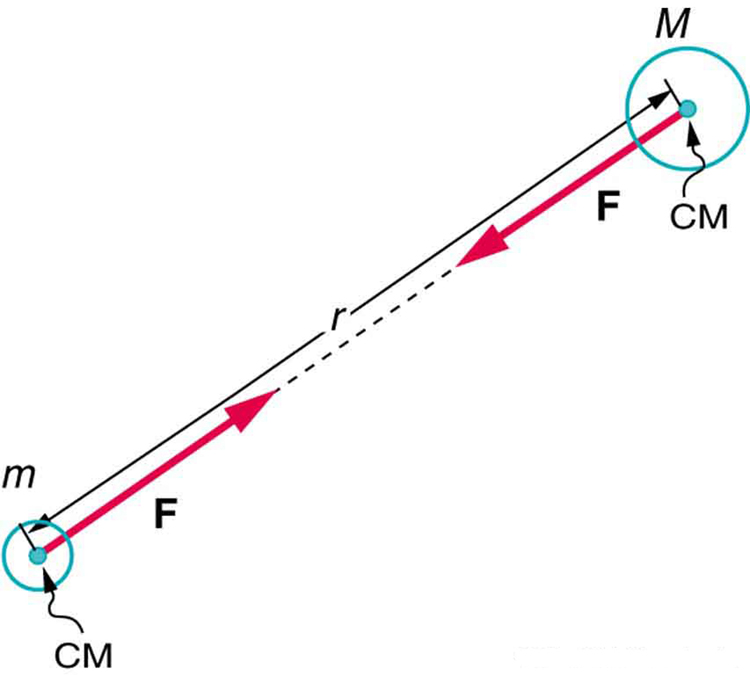
Center of Mass and Simplification
For extended bodies like planets or humans, we assume their mass is concentrated at a point—their center of mass. This simplifies gravitational calculations, particularly when the distance between objects is much larger than their size.
Deriving the Acceleration Due to Gravity [latex]g[/latex]
Let’s connect Newton’s law of gravitation to the acceleration of falling objects on Earth. Recall that weight is defined as:
[latex]F = mg[/latex]
Substituting into Newton’s gravitational equation:
[latex]mg = G \frac{mM}{r^2}[/latex]
Solving for [latex]g[/latex]:
[latex]g = G \frac{M}{r^2}[/latex]
Using Earth's values:
-
[latex]M = 5.98 \times 10^{24} , \text{kg}[/latex]
-
[latex]r = 6.38 \times 10^6 , \text{m}[/latex] (Earth’s radius)
[latex]g = \left(6.67 \times 10^{-11} , \frac{\text{N} \cdot \text{m}^2}{\text{kg}^2} \right) \frac{5.98 \times 10^{24} , \text{kg}}{(6.38 \times 10^6 , \text{m})^2} = 9.80 , \text{m/s}^2[/latex]
This result is consistent with the observed acceleration due to gravity on Earth, and it shows that all objects—regardless of mass—fall at the same rate near Earth's surface.
Figure 39.3 shows the gravitational interaction between Earth and an object, emphasizing that [latex]r[/latex] is the distance to Earth’s center.
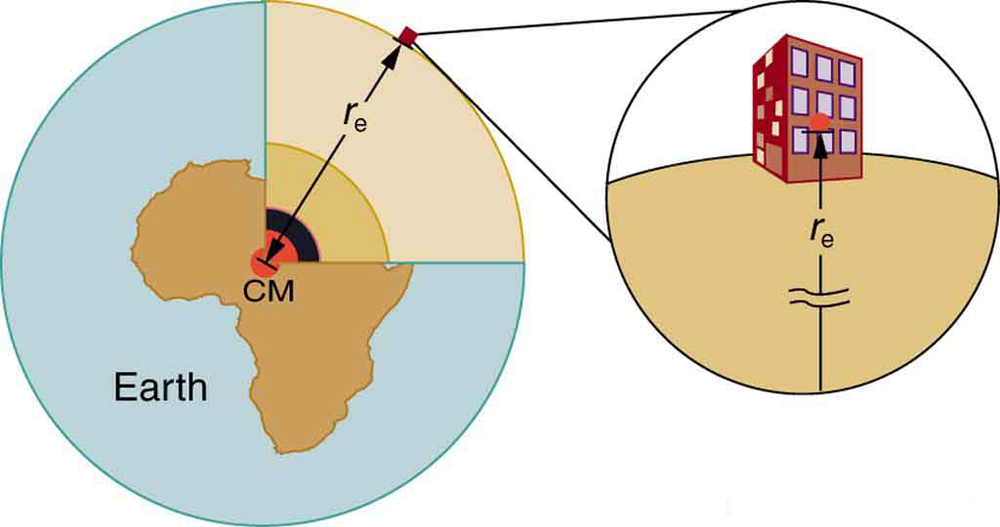
Misconception Alert: Equal Force on Unequal Masses
One common misunderstanding is that heavier objects exert more gravitational force. While heavier objects do exert larger forces on lighter ones, Newton’s third law ensures the forces are equal and opposite. The difference lies in the acceleration, which is smaller for the more massive body.
Take-Home Experiment
Try dropping a marble, a spoon, and a ball from the same height. Do they hit the ground at the same time? Likely, yes. Now try a sheet of paper—its slower fall is due to air resistance, not gravitational mass.
Broader Context: Gravitational Force in Modern Physics
Although Newton’s law remains powerful, modern physics—especially Einstein’s General Relativity—treats gravity as the curvature of space-time rather than a force. Still, Newton’s equation accurately predicts planetary motion and everyday gravitational effects.
Preview of the Cavendish Experiment
In the next section, we’ll explore Henry Cavendish’s experiment, which provided the first accurate measurement of the gravitational constant [latex]G[/latex], enabling scientists to weigh Earth and validate Newton’s equation with laboratory-scale data.
Example 39.1: Earth’s Gravitational Force Is the Centripetal Force Making the Moon Move in a Curved Path
- Find the acceleration due to Earth’s gravity at the distance of the Moon.
- Calculate the centripetal acceleration needed to keep the Moon in its orbit (assuming a circular orbit about a fixed Earth), and compare it with the value of the acceleration due to Earth’s gravity that you have just found.
Strategy for (a)
This calculation is the same as the one finding the acceleration due to gravity at Earth’s surface, except that [latex]r[/latex]is the distance from the center of Earth to the center of the Moon. The radius of the Moon’s nearly circular orbit is [latex]3\text{.}\text{84}×{\text{10}}^{8}\phantom{\rule{0.25em}{0ex}}\text{m}[/latex].
Solution for (a)
Substituting known values into the expression for [latex]g[/latex] found above, remembering that [latex]M[/latex] is the mass of Earth not the Moon, yields
Strategy for (b)
Centripetal acceleration can be calculated using either form of
We choose to use the second form:
where [latex]\omega[/latex] is the angular velocity of the Moon about Earth.
Solution for (b)
Given that the period (the time it takes to make one complete rotation) of the Moon’s orbit is 27.3 days, (d) and using
we see that
The centripetal acceleration is
The direction of the acceleration is toward the center of the Earth.
Discussion
The centripetal acceleration of the Moon found in (b) differs by less than 1% from the acceleration due to Earth’s gravity found in (a). This agreement is approximate because the Moon’s orbit is slightly elliptical, and Earth is not stationary (rather the Earth-Moon system rotates about its center of mass, which is located some 1700 km below Earth’s surface). The clear implication is that Earth’s gravitational force causes the Moon to orbit Earth.
Earth and Moon: Mutual Gravitation
Although it seems the Moon orbits a stationary Earth, this is not entirely true. According to Newton’s third law, the gravitational force the Earth exerts on the Moon is matched by an equal and opposite force the Moon exerts on Earth.
Both Earth and the Moon orbit their common center of mass, which lies inside Earth but not at its exact center (Figure 39.4). This mutual orbit causes small "wiggles" in Earth's path around the Sun—subtle variations observable in the motion of stars that reveal the presence of exoplanets orbiting them.
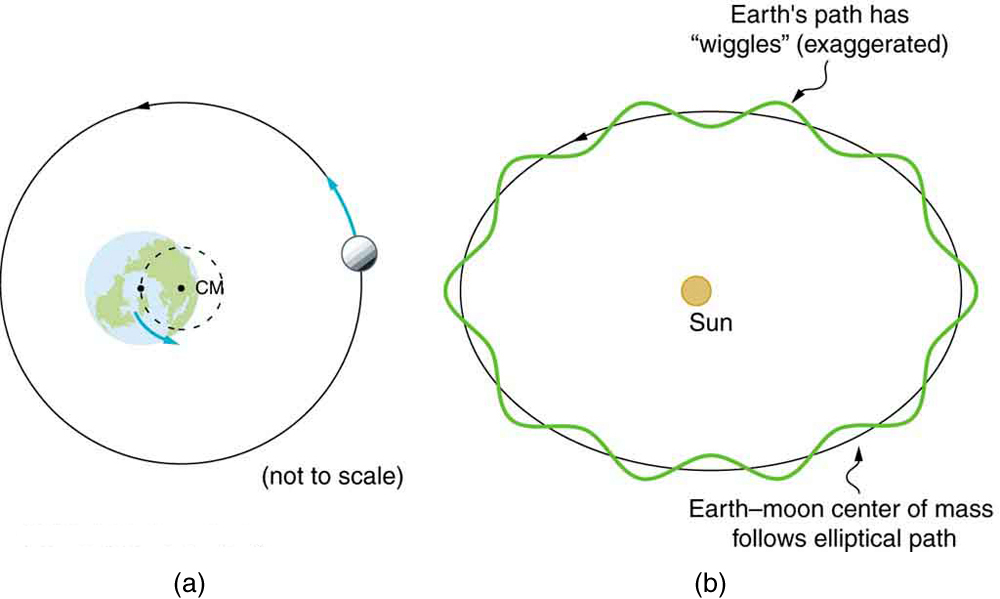
Tides: Evidence of the Moon’s Gravitational Pull
One of the most visible consequences of the Moon’s gravity is tides on Earth’s oceans. Because water is mobile, the Moon’s gravity pulls more strongly on the side of Earth closest to it, creating a high tide. A second high tide occurs on the far side, where Earth is pulled away from the water (Figure 39.5).
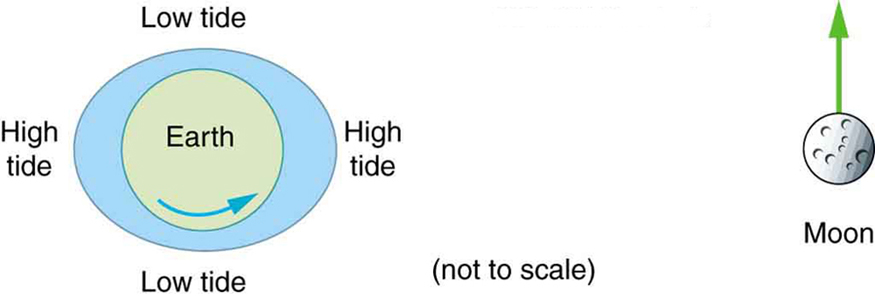
As Earth rotates under these tidal bulges, most coastal locations experience two high tides and two low tides every 24 hours and 50.4 minutes, aligning with the Moon’s orbital motion.
The Sun also contributes to tides, but its influence is only about half that of the Moon. When the Sun, Earth, and Moon align (new or full moon), their gravitational effects reinforce one another, creating spring tides, the highest tides. When they form a right angle (first or third quarter), the effects partially cancel, causing neap tides, the smallest tides (Figure 39.6).
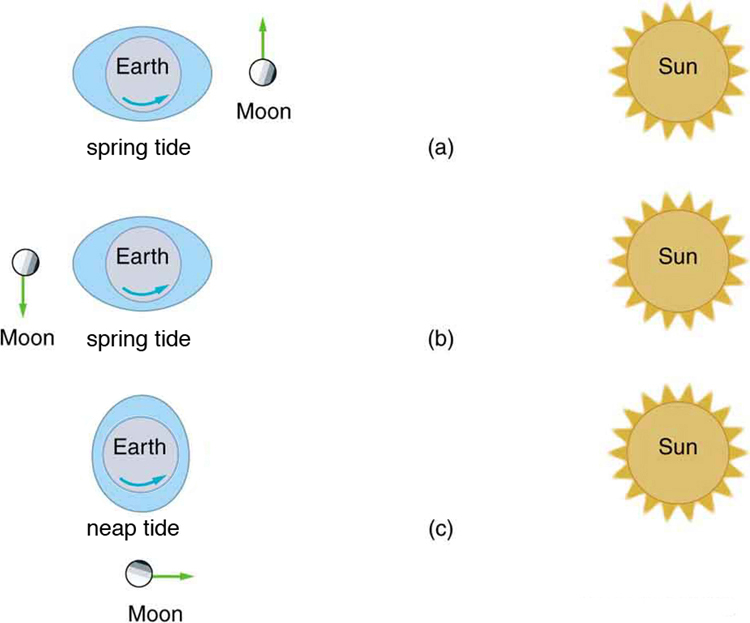
Tidal effects also occur in extreme conditions—near black holes, for instance. These objects generate such intense tidal forces that they can tear matter from nearby stars, forming luminous accretion disks (Figure 39.7).
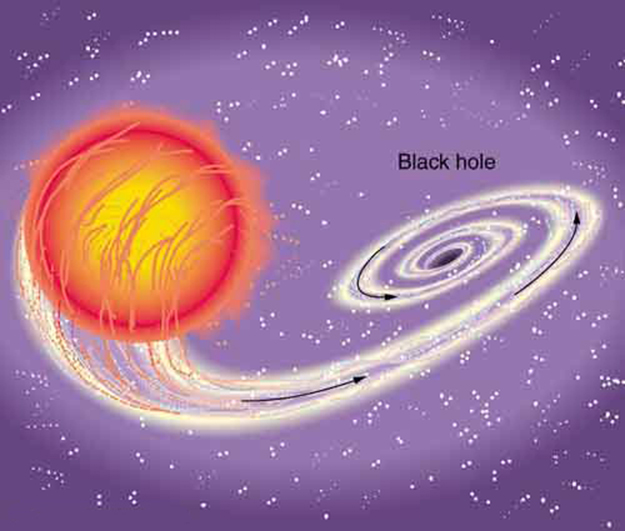
“Weightlessness” and Microgravity in Orbit
Astronauts in orbit appear weightless, but gravity is still acting on them. They are in free fall, continuously falling toward Earth but traveling forward fast enough to remain in orbit. This state is known as apparent weightlessness, illustrated by astronauts aboard the International Space Station (Figure 39.8).
In such environments, microgravity—very small net acceleration—is experienced. This has significant biological and technological implications:
-
Muscle atrophy and bone density loss are common in astronauts.
-
Cardiovascular adaptations occur due to loss of pressure gradients.
-
The immune system weakens, increasing infection risk.
-
Some bacteria grow faster in space, while others produce more antibiotics.
-
High-quality crystal growth in microgravity enables advanced materials research.
Plants, which rely on gravity to orient their roots and shoots, may play vital roles in life support systems during long-term space missions. However, more research is needed on how microgravity affects their development.
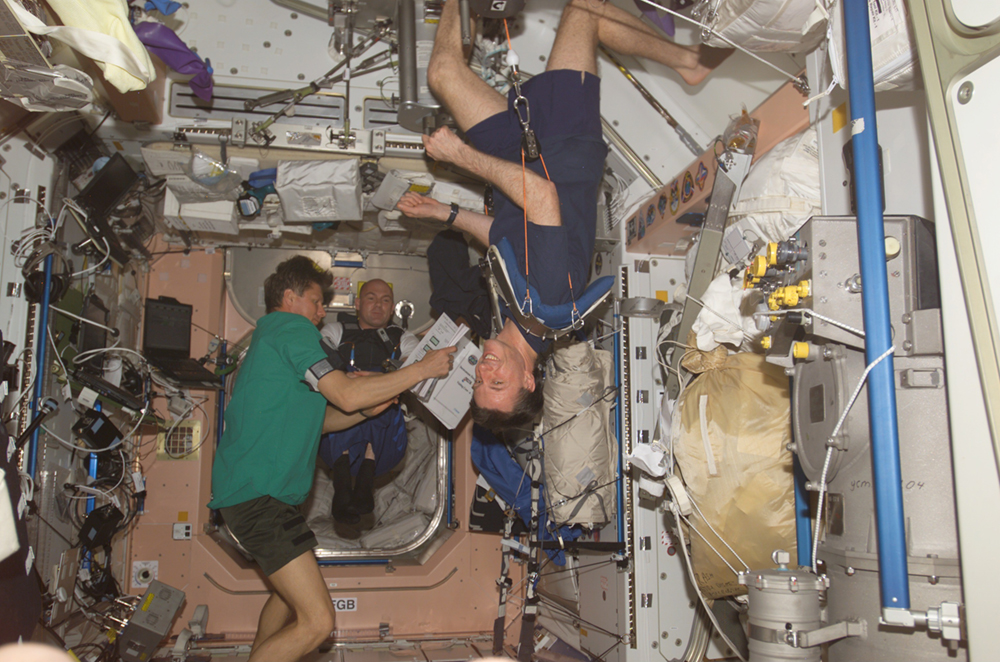
The Cavendish Experiment: Measuring [latex]G[/latex]
The gravitational constant [latex]G[/latex] was first measured by Henry Cavendish in 1798 using a torsion balance apparatus (Figure 39.9). This device measured the tiny attraction between lead spheres, allowing Cavendish to calculate the strength of gravity between known masses.
Using Newton’s law:
[latex]F = G \frac{mM}{r^2}[/latex]
and substituting [latex]F = mg[/latex] (the object's weight), we get:
[latex]mg = G \frac{mM}{r^2}[/latex]
Canceling [latex]m[/latex]:
[latex]g = G \frac{M}{r^2}[/latex]
Solving for Earth’s mass:
[latex]M = \frac{gr^2}{G}[/latex]
With accurate values for [latex]g[/latex], [latex]r[/latex] (Earth’s radius), and [latex]G[/latex], we can compute Earth's mass. This was one of the first scientific estimates of a planet’s mass.
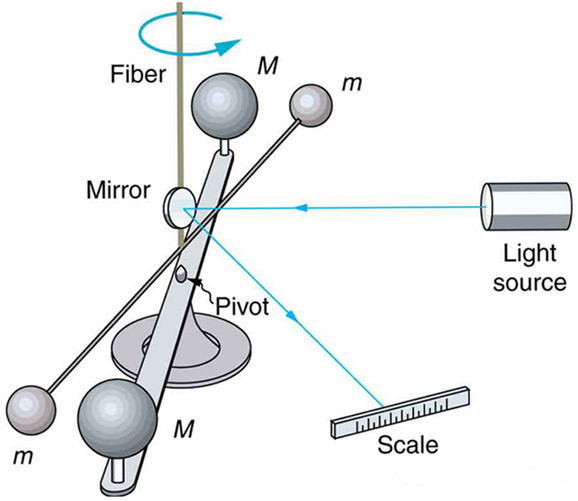
Modern Advances in Gravitational Experiments
Experiments following Cavendish's method have refined our understanding of gravity:
-
Eötvös-type experiments confirmed that gravity acts equally on all substances, supporting the equivalence principle.
-
Modern torsion balances test gravity’s behavior at millimeter scales, searching for deviations from the inverse-square law.
-
These tests also probe for a fifth force or signs of quantum gravity.
-
Recent studies confirm that gravitational energy contributes to mass, in line with general relativity.
These continued efforts help us verify and extend Newton’s ideas, bridging toward modern theories of gravity.
Section Summary
-
Newton’s Universal Law of Gravitation states that:
Every mass attracts every other mass through a force proportional to the product of their masses and inversely proportional to the square of the distance between them.
Mathematically:
[latex]F = G \frac{mM}{r^2}[/latex]
-
[latex]F[/latex] is the gravitational force,
-
[latex]G = 6.674 \times 10^{-11} , \text{N} \cdot \text{m}^2/\text{kg}^2[/latex],
-
[latex]m[/latex] and [latex]M[/latex] are the masses involved,
-
[latex]r[/latex] is the distance between their centers of mass.
This law applies universally—from falling apples to orbiting galaxies—and continues to be confirmed by experiments and observations.
-
Conceptual Questions
- Action at a distance, such as is the case for gravity, was once thought to be illogical and therefore untrue. What is the ultimate determinant of the truth in physics, and why was this action ultimately accepted?
- Two friends are having a conversation. Anna says a satellite in orbit is in freefall because the satellite keeps falling toward Earth. Tom says a satellite in orbit is not in freefall because the acceleration due to gravity is not [latex]9.80 m{\text{/s}}^{2}[/latex]. Who do you agree with and why?
- Draw a free body diagram for a satellite in an elliptical orbit showing why its speed increases as it approaches its parent body and decreases as it moves away.
- Newton’s laws of motion and gravity were among the first to convincingly demonstrate the underlying simplicity and unity in nature. Many other examples have since been discovered, and we now expect to find such underlying order in complex situations. Is there proof that such order will always be found in new explorations?
Problem Exercises
- (a) Calculate Earth’s mass given the acceleration due to gravity at the North Pole is [latex]9.830 m{\text{/s}}^{2}[/latex] and the radius of the Earth is 6371 km from center to pole. (b) Compare this with the accepted value of [latex]5\text{.}\text{979}×{\text{10}}^{\text{24}}\phantom{\rule{0.25em}{0ex}}\text{kg}[/latex].
- (a) Calculate the magnitude of the acceleration due to gravity on the surface of Earth due to the Moon. (b) Calculate the magnitude of the acceleration due to gravity at Earth due to the Sun. (c) Take the ratio of the Moon’s acceleration to the Sun’s and comment on why the tides are predominantly due to the Moon in spite of this number.
- (a) What is the acceleration due to gravity on the surface of the Moon? (b) On the surface of Mars? The mass of Mars is [latex]6.418×{\text{10}}^{\text{23}}\phantom{\rule{0.25em}{0ex}}\text{kg}[/latex] and its radius is [latex]3\text{.}\text{38}×{\text{10}}^{6}\phantom{\rule{0.25em}{0ex}}\text{m}[/latex].
- (a) Calculate the acceleration due to gravity on the surface of the Sun. (b) By what factor would your weight increase if you could stand on the Sun? (Never mind that you cannot.)
- The Moon and Earth rotate about their common center of mass, which is located about 4700 km from the center of Earth. (This is 1690 km below the surface.) (a) Calculate the magnitude of the acceleration due to the Moon’s gravity at that point. (b) Calculate the magnitude of the centripetal acceleration of the center of Earth as it rotates about that point once each lunar month (about 27.3 d) and compare it with the acceleration found in part (a). Comment on whether or not they are equal and why they should or should not be.
- Astrology, that unlikely and vague pseudoscience, makes much of the position of the planets at the moment of one’s birth. The only known force a planet exerts on Earth is gravitational. (a) Calculate the magnitude of the gravitational force exerted on a 4.20 kg baby by a 100 kg father 0.200 m away at birth (he is assisting, so he is close to the child). (b) Calculate the magnitude of the force on the baby due to Jupiter if it is at its closest distance to Earth, some [latex]6\text{.}\text{29}×{\text{10}}^{\text{11}}\phantom{\rule{0.25em}{0ex}}\text{m}[/latex] away. How does the force of Jupiter on the baby compare to the force of the father on the baby? Other objects in the room and the hospital building also exert similar gravitational forces. (Of course, there could be an unknown force acting, but scientists first need to be convinced that there is even an effect, much less that an unknown force causes it.)
- The existence of the dwarf planet Pluto was proposed based on irregularities in Neptune’s orbit. Pluto was subsequently discovered near its predicted position. But it now appears that the discovery was fortuitous, because Pluto is small and the irregularities in Neptune’s orbit were not well known. To illustrate that Pluto has a minor effect on the orbit of Neptune compared with the closest planet to Neptune: (a) Calculate the acceleration due to gravity at Neptune due to Pluto when they are [latex]4\text{.}\text{50}×{\text{10}}^{\text{12}}\phantom{\rule{0.25em}{0ex}}\text{m}[/latex] apart, as they are at present. The mass of Pluto is [latex]1\text{.}4×{\text{10}}^{\text{22}}\phantom{\rule{0.25em}{0ex}}\text{kg}[/latex]. (b) Calculate the acceleration due to gravity at Neptune due to Uranus, presently about [latex]2\text{.}\text{50}×{\text{10}}^{\text{12}}\phantom{\rule{0.25em}{0ex}}\text{m}[/latex] apart, and compare it with that due to Pluto. The mass of Uranus is [latex]8\text{.}\text{62}×{\text{10}}^{\text{25}}\phantom{\rule{0.25em}{0ex}}\text{kg}[/latex].
- (a) The Sun orbits the Milky Way galaxy once each [latex]2\text{.}{\text{60 x 10}}^{8}\phantom{\rule{0.25em}{0ex}}\text{y}[/latex], with a roughly circular orbit averaging [latex]3\text{.}{\text{00 x 10}}^{4}[/latex] light years in radius. (A light year is the distance traveled by light in 1 y.) Calculate the centripetal acceleration of the Sun in its galactic orbit. Does your result support the contention that a nearly inertial frame of reference can be located at the Sun? (b) Calculate the average speed of the Sun in its galactic orbit. Does the answer surprise you?
- Unreasonable Result A mountain 10.0 km from a person exerts a gravitational force on him equal to 2.00% of his weight. (a) Calculate the mass of the mountain. (b) Compare the mountain’s mass with that of Earth. (c) What is unreasonable about these results? (d) Which premises are unreasonable or inconsistent? (Note that accurate gravitational measurements can easily detect the effect of nearby mountains and variations in local geology.)
Glossary
- gravitational constant, G
- a proportionality factor used in the equation for Newton’s universal law of gravitation; it is a universal constant—that is, it is thought to be the same everywhere in the universe
- center of mass
- the point where the entire mass of an object can be thought to be concentrated
- microgravity
- an environment in which the apparent net acceleration of a body is small compared with that produced by Earth at its surface
- Newton’s universal law of gravitation
- every particle in the universe attracts every other particle with a force along a line joining them; the force is directly proportional to the product of their masses and inversely proportional to the square of the distance between them
every particle in the universe attracts every other particle with a force along a line joining them; the force is directly proportional to the product of their masses and inversely proportional to the square of the distance between them
a proportionality factor used in the equation for Newton’s universal law of gravitation; it is a universal constant—that is, it is thought to be the same everywhere in the universe
the point where the entire mass of an object can be thought to be concentrated
an environment in which the apparent net acceleration of a body is small compared with that produced by Earth at its surface

